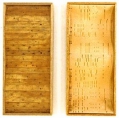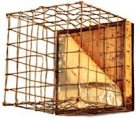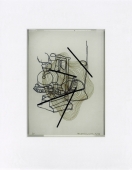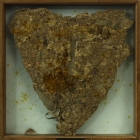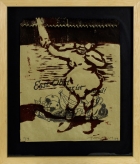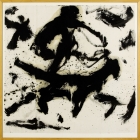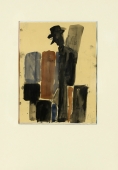
Artist | James Powditch (*1966)
https://www.artist-info.com/artist/James-Powditch
Biography
Biography
James was born 5th November 1966 in Sydney, Australia
1985 - 88 he studied at City Art Institute, Paddington, Sydney majoring in film.
He has worked extensively for theatre and dance companies as a set builder, props maker and scenic artist
About the work (english)
About the work (english)
Thingummyjigs
Art's advantage over TV, cinema and the mass media is its materiality. Handmade visual art is the only major cultural practice unassimilable by mass media. "Painting is," wrote Robert Hughes, "exactly what mass visual media are not: a way of specific engagement, not of general seduction. "It is the unrepeatable thingness of art that constitutes its special power. But how much of art exists? And how much is a dream? Two exhibitions this week - among the most fecund, satisfying shows I have seen all year - tantalised me with their material beauty. On the one hand I wanted to touch, stand back, get close, lick, sniff. But on the other, my eyes were continually glazing over, propelled into sweet, aimless reverie. How do you make sense of this tension between material thingness and the gauzy insubstantiality of dreams, which is the true currency of art? ...
...He's nailed it
James Powditch's exhibition at Queen Street Fine Art is a gem. Powditch is young, laconic, unpretentious, articulate and terrifically talented. He has worked as a props-maker for dance and theatre companies, which seems to have provided him with invaluable experience in the areas of carpentry, construction and whimsical invention. He is a sculptor, or an "assembler", who uses a combination of fresh timber and an assortment of other materials, including canvas, weathered wood, paint, copper, corrugated iron and found objects such as pianola rolls and bicycle gears. There are artists around who know all too well the easy aesthetic satisfactions of placing scraggly found objects against clean white walls. Anyone can do it. Powditch does much more. Much of this show takes its cue from the architecture of the great Frank Lloyd Wright. Powditch turns the architect's designs into elongated geometrical configurations that ride the wall with elegant authority. Several, including the brilliant 70mm series and the two "Guggenheim" works, curve out softly from the wall. Other works in the show are influenced by the fields of sun-drenched, pastel colours in Richard Diebenkorn's paintings. There is humour in many of these pieces. But almost everything feels pared back, understated, carefully finished. Again, there is that tension between material thingness and ethereal flights of imagination, which seems a hallmark of significant art. Until July 25. Phone 9363 3358.
Sydney Morning Herald 6th July 1999
The Galleries by Sebastian Smee
Exhibition at Queen Street Fine Art, woollahra
30 june - 25 july 1999
Featuring at Queen Street Fine Art during July are the architecturally influenced sculptures of James Powditch. Often finding thematic unity in the raw simplicity and unrefined beauty of found materials, be they weathered and worn or scratched and battered, Powditch's new exhibition has been inspired by the buildings of the American architect Frank Lloyd Wright. It was while watching a documentary on Wright on Arts Sunday last year that Powditch was reminded of his art studies in high school - past memories and new ideas simultaneously motivating works such as Guggenheim, Temple and Falling Water.The sculptures whilst predominately made from timber utilise a large range of materials - raw canvas, copper plating, corrugated iron and discarded rusty iron pieces come together to form visually distinctive mixed media works. James Powditch studied at the City Art Institute in Paddington and now works from his studio in Newtown. He has had several solo exhibitions, participated in a large number of group shows and features prominently in the corporate collections of AON Worldwide Insurance and Societe Generale.The exhibition consists of approximately twenty wall pieces and four free-standing works and is on display at Queen Street Fine Art (Woollahra, NSW) from June 30 until July 25, 1999.
The heart and inspiration for all of Powditch's work is the "stuff" he uses - brute materials weathered and worn, scratched and battered. In his work these overlooked, discarded objects take centre stage. Which is truer than it sounds. Powditch is a big film buff. He uses his materials as Tarantino uses actors, rescuing them from obscurity, he drags their previously unsuspecting qualities into the spotlight.
Yet it is not the "stuff" in itself that makes it art. It is the visual literacy with which the works are constructed. He often sees his sculptures as film, in particular the long horizontal pieces can be viewed as widescreen, 70mm compositions. Each segment becomes a frame or a scene. The decision is how to flow from one scene/segment to the next. Whilst each segment is interesting in itself, together they form a coherent narrative. The main visual links are his use of verticals and horizontals, endlessly repeated and endlessly varied. Lines of pianola scroll rhyme with lengths of bicycle chain. The cracked paint and grain of old fence pailings bleached by sunshine, sidle up against the hard history of a rectangular slab of crumpled tin.
These works are not glossy reproductions of the world, they are part of its crust.
Text by Peter Duggan
Designs on Debris
Sculptor James Powditch has one thing in common with Quentin Tarantino. Recycling. He uses materials in much the same way the Hollywood director recycles has-been actors - rescuing them from obscurity and resurrecting their careers. Brute materials have become the focus of his artwork. If they're weathered, worn, scratched and battered, he'll use it, but forget new stuff. It's hard to imagine how a door knob, wire and cracked red- and turquoise-painted timber can be transformed into a sculpture. Powditch sees his sculptures as film, represented by long horizontal pieces viewed as a widescreen composition. Each frame becomes a scene to make up a narrative. "Nearly everything is done with screen prose and a title name is given to each sculpture," Powditch said. "The decision is how to flow from one scene/segment to the next. "It's hard suggesting what the piece will be about. If I find some materials one day, I might go in a completely different direction." The main visual links are his use of vertical and horizontal frames, repeated and varied. Powditch separates his work into blocks, concentraing on themes of film, music and the influences of contemporary artists. He draws inspiration from film makers such as Francis Ford Coppola and Whitney Scott, who have very distinctive visual work. The Cleft Pallette, Sardine Symphony and Guitar and three prominent sculptures representing styles of music. Sardine Symphony shows three different violins featuring worn materials like a violin bow, oak timber, aluminium, paper and plastic. In the last six years, Powditch has collected materials from laneways, junk shops, Newtown streets, the countryside and friends. After working as a carpenter in a theatre company for 10 years and with a background in architecture, Powditch has put his mental and physical attributes into producing a "very geometric and precise construction". Powditch's laconic approach to his first exhibition shows a contemporary refreshing style. Level One Director Jas Hugonnet said Powditch has a great eye for dividing unusual materials into a sophisticated piece of artwork.
James Powditch's sculptures are on display until August 19, 1999, Level One Gallery, Newtown.
Text by Saxon Cheng, Daily Telegraph 31st July 1998
Well-Judged Two-Hander
I recommend a well-judged two-hander at Tapp Gallery in Darlinghurst. This artist-run space boasts a hit-or-miss exhibition policy that occasionally fires. Like a latter-day incarnation of the Americans Rauschenberg and Johns, artist they patently admire, James Powditch and Rodney Simmons appear to work off each other's energies without succumbing to imitation. Powditch constructs orderly wall-reliefs and objects. Simmons paints disorderly, deliquescent abstracts. Their methods and means are almost oppositional but they arrive at, or aim for, a similar moment of visual resolution. Few shows in established commercial venues this week are as rewarding as this. Though Powditch errs on the side of tameness, his constructions are the well-fashioned products of a true sculptural sensibility. His feeling for the understated intervals of distance and depth that determine shapeliness are authoritative. And he knows about texture, for God's sake, rarer in this medium than you'd think. In canvas after modestly-scaled canvas, Simmons succeeds in evoking a painterly condition akin to breathiness. I sense in the work a rhythm of intake and exhalation, now short, now long, according to emotional mood as much as manual movement. As with Cy Twombly, his scribble is simply calligraphy unravelled.
"The Galleries" by Bruce James, 1997
Solo Exhibitions
Solo Exhibitions
Jun 1999 Sculpture, Queen Street Fine Art, Woollahra, Sydney
Jul 1998 Sculpture, Level Gallery, Newtown, Sydney
Nov 1997 Sculpture, TAP Gallery, Darlinghurst, Sydney
Mar 1997 Sculpture, TAP Gallery, Darlinghurst, Sydney
Group Exhibitions
Group Exhibitions
Jun 1999 Still Life, King Street Gallery, Newtown, Sydney
May 1999 Little Gems (10th birthday show), Tap Gallery, Darlinghurst, Sydney
Apr 1999 Implant, Level Gallery, Newtown, Sydney
Dec 1998 Crickart, Bat & Ball Hotel, Surry Hills, Sydney
Nov 1998 Defiant 6 (6x6x6” miniature show), Defiance, Newtown, Sydney
Oct 1998 Walking the Streets, Oxford Tavern, King Street, Newtown, Sydney (Newtown Festival)
Jun 1998 Figure in the Landscape, King Street Gallery, Newtown, Sydney
Mar 1998 Why Not?, TAP Gallery, Darlinghurst, Sydney
Feb 1998 Guitar Shaped World, Tamworth City Art Gallery (Tamworth Country Music Festival) Oct 1997 Biggest Little Sculpture Show in Town (6x6x6” miniature show), Defiance, Newtown, Sydney
Jan 1997 Art for East Timor, Bondi Pavilion (Sydney Fringe Festival), Sydney
1995 Recent Works, Harbour Graphics, Sydney
1993 & 1994 Walking the Streets, Oxford Tavern, King Street, Newtown, Sydney (Newtown Festival)
1992 Artists Behind the Scenes, Sydney Theatre Company, The Rocks, Sydney
1992 Art in Shopfronts, Oxford Street, Paddington, Sydney
1989 Artists Behind the Scenes, Sydney Theatre Company, The Rocks, Sydney
Corporate & Private Collections/Commissions
Corporate & Private Collections/Commissions
1999 Sculpture, AON Worldwide Insurance, Sydney
1999 Sculpture, Societé Generale, Sydney
1998 Sculpture, Suncorp-Metway, Sydney
1998 Sculpture, Audi, Sydney
1994-1996 Murals, Oxford Tavern, Newtown, Sydney
1993 “Delfino” mural, P&O Fairstar, Sydney
1986 Cover illustration, Coping with Grief, ABC Publications, Sydney
1985 Drawing collection, Billy Blue Magazine, Sydney
Reviews/Articles
Reviews/Articles
6 May 1999 Sebastian Smee, “Space Shuttle”, The Sydney Morning Herald
31 Jul 1998 Saxon Cheng, “Designs on Debris”, The Daily Telegraph, Sydney
14 Nov 1997 Bruce James, The Sydney Morning Herald
Internet
Internet
 offers / Requests offers / Requests  |
About this service |
|---|
 Exhibition Announcements Exhibition Announcements  |
About this service |
|---|
 Visualization |
Learn more about this service | ||
|---|---|---|---|

Interested in discovering more of this artist's networks?
3 easy steps: Register, buy a package for a visualization, select the artist.
See examples how visualization looks like for an artist, a curator, or an exhibition place: Gallery, museum, non-profit place, or collector.

Exhibition History

|
SUMMARY based on artist-info records. More details and Visualizing Art Networks on demand. Venue types: Gallery / Museum / Non-Profit / Collector |
||||
| Exhibitions in artist-info | 1 (S 1/ G 0) |
Shown Artists - 0 of 0 artists (no. of shows) - all shows - Top 100 |
||
| Exhibitions by type | 1: 1 / 0 / 0 / 0 | |||
| Venues by type | 1: 1 / 0 / 0 / 0 | |||
| Curators | 0 | |||
| artist-info records | Jun 1999 - Jul 1999 | |||
|
Countries - Top 1 of 1 Australia (1) |
Cities 1 - Top of 1 Sydney (1) |
Venues (no. of shows )
Top 1 of 1
|
||
|
Curators (no. of shows)
Top 0 of 0 |
| Queen Street Fine Art | S | Jun 1999 - Jul 1999 | Sydney | (1) | +0 | |
| Keep reading |



















